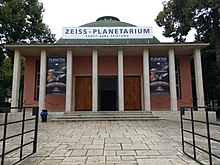Jena Planetarium
The Zeiss Planetarium in Jena is the oldest operating planetarium in the world . It opened on July 18, 1926. The Zeiss Planetarium is a projection planetarium in which the fixed stars and the planets are projected onto the inside of a white dome. The owner and operator of the planetarium is the Ernst Abbe Foundation . It was visited over 150,000 times in 2019.
history
The development of the planetarium is based on an idea by Oskar von Miller , the founder of the Deutsches Museum in Munich, who planned the construction of a Ptolemaic planetarium in the style of a walk-in celestial globe with a mechanical device for displaying the planetary orbits in his institution as early as 1912 . In 1913 he turned to the Carl Zeiss company in Jena to realize this . Since the original project turned out to be technically too complex and hardly feasible, Walther Bauersfeld designed the basic form for a planetarium device based on optomechanical light projection in early 1919 . This was installed as Model I in Munich in 1924 .
From the end of July 1924, around 80,000 people attended the first test demonstrations of the artificial starry sky in a temporary dome on the roof of the Jena Zeiss works, which was celebrated in the press as the "miracle of Jena". Due to the great response and demand from other cities and regions, the Carl Zeiss company began planning a large and permanent planetarium in Jena and further developing the projector into the Zeiss planetarium - later called Model II . Planning and design were in place within a few months, and at the end of 1924 construction began on the Jena 25-meter planetarium based on the designs by architects Schreiter & Schlag in what was then the Prinzessinnengarten. After the first large planetariums were opened in Wuppertal-Barmen, Leipzig and Düsseldorf in 1926, Jena followed on July 18, 1926 as number four worldwide.
In 1984/85 the planetarium was comprehensively expanded structurally and technically. The installation of computer-controlled technology as well as the exchange with other planetariums on both sides of the iron curtain led to a reorientation in the range of programs and visitor service. In 1993, further technical innovations followed in the field of peripheral projection technologies such as all-sky slide projection and panorama systems. In 1996, the Zeiss Cosmorama star projector, still in the classic dumbbell shape, was replaced by the Starball model VIII "Universarium", also from Carl Zeiss Jena GmbH. After extensive structural restructuring, the planetarium was expanded in October 2004 to include the “Bauersfeld” restaurant. In 2006 the laser-based all -dome projection system ADLIP (All Dome Laser Image Projection) from Carl Zeiss and Jenoptik was installed . The Jena planetarium thus became the first laser-based full-domain planetarium in Europe.
Current projection technology
Digital full dome projection
On November 3, 2011, a completely new video and audio system was installed, which was titled with the term "The New Planetarium". It is a Powerdome Velvet projection system from Zeiss, which enables a realistic display of light-dark contrasts and replaces the Adlip system used previously. This enables a higher resolution of up to 4096 × 4096 pixels and an increased contrast ratio of 2,500,000: 1.
With the help of eight synchronously working Velvet projectors, it is possible to display moving images on the entire dome with an area of more than 800 m². The partial images are faded into one another in such a way that the viewer does not see any transitions, but only an overall image on the dome. The projectors are installed on the edge of the dome.
With the laser projection, Zeiss also supplies the imaging computer system “PowerDome”. This system takes care of the distortion correction , the distribution of the overall image to the individual projectors and the edge blending in real time.
Optomechanical star projection
The "old" heart of the planetarium is the model VIII star projector installed in 1996. With it it is possible to depict the firmament in a deceptively real way.
Projection dome
For the construction of the planetarium, new calculations and manufacturing methods for thin-walled domes ( shells ) made of concrete were developed for the first time . The planetarium with its hemispherical dome was developed by Walther Bauersfeld . It consists of a network of rods similar to the geodesic domes built by Richard Buckminster Fuller in later years . The dome of the planetarium was built in Zeiss-Dywidag shell construction by the construction company Dyckerhoff & Widmann AG and designed by Franz Dischinger . The only six centimeters thick concrete shell of the planetarium dome has a diameter of 25 meters.
Planetarium programs
Like many other large planetariums, the Jena Planetarium has a long tradition of in-house planetarium show production. In addition to classic, live star tours, a wide range of multimedia educational and entertainment events is shown in the Jena Planetarium.
Others
The new sound system - the 3D sound system "SpatialSoundWave" - is the world's first permanent installation from the Ilmenau Fraunhofer Institute for Digital Media Technology IDMT in a planetarium dome and ensures a special kind of spatial sound experience, as it works with wave field synthesis .
literature
- Franz-Ferdinand von Falkenhausen, Otto Haueis, Ute Leonhardt, Otto Wiegand, Wolfgang Wimmer: Carl Zeiss in Jena 1846 to 1946 , Sutton Verlag GmbH, 2004
See also
Web links
- Zeiss Planetarium Jena
- Ostthüringer Zeitung - How the Jena mayor saved the planetarium in 1924
- TU Berlin - Krausse: Architecture from the spirit of projection. The Zeiss Planetarium. - Detailed text on architecture and technology
Individual evidence
- ↑ Planetarium sets record number of visitors: new show starts. In: Süddeutsche Zeitung . January 27, 2020, accessed January 30, 2020 .
Coordinates: 50 ° 55 ′ 54 ″ N , 11 ° 35 ′ 13 ″ E






